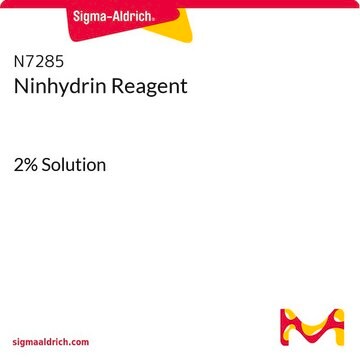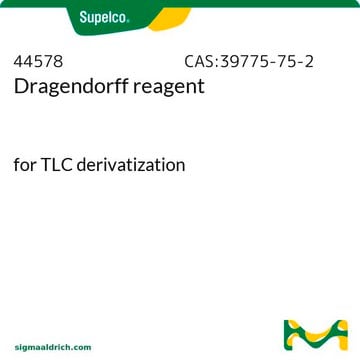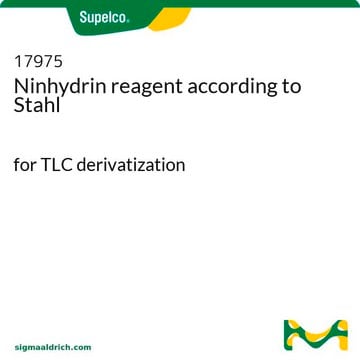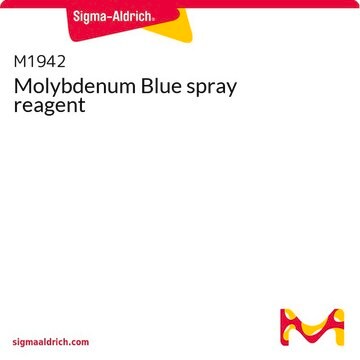N0507
Ninhydrin spray reagent
0.2% in ethanol
Sinónimos:
Ninhydrin solution
Iniciar sesiónpara Ver la Fijación de precios por contrato y de la organización
About This Item
Fórmula empírica (notación de Hill):
C9H6O4
Número de CAS:
Peso molecular:
178.14
Número MDL:
Código UNSPSC:
12352100
ID de la sustancia en PubChem:
Productos recomendados
formulario
liquid
Nivel de calidad
concentración
0.2% in ethanol
temp. de almacenamiento
2-8°C
cadena SMILES
OC1(O)C(=O)c2ccccc2C1=O
InChI
1S/C9H6O4/c10-7-5-3-1-2-4-6(5)8(11)9(7,12)13/h1-4,12-13H
Clave InChI
FEMOMIGRRWSMCU-UHFFFAOYSA-N
¿Está buscando productos similares? Visita Guía de comparación de productos
Aplicación
amino acids, amines and amino sugars.
sustituido por
Referencia del producto
Descripción
Precios
Certificados de análisis (COA)
Busque Certificados de análisis (COA) introduciendo el número de lote del producto. Los números de lote se encuentran en la etiqueta del producto después de las palabras «Lot» o «Batch»
¿Ya tiene este producto?
Encuentre la documentación para los productos que ha comprado recientemente en la Biblioteca de documentos.
Matthew G Romei et al.
Science (New York, N.Y.), 367(6473), 76-79 (2020-01-04)
Rotation around a specific bond after photoexcitation is central to vision and emerging opportunities in optogenetics, super-resolution microscopy, and photoactive molecular devices. Competing roles for steric and electrostatic effects that govern bond-specific photoisomerization have been widely discussed, the latter originating
Yu-Feng Xie et al.
Journal of neurochemistry, 122(3), 605-618 (2012-05-23)
Neurons located in the trigeminal subnucleus caudalis (Vc) play crucial roles in pain and sensorimotor functions in the orofacial region. Because of many anatomical and functional similarities with the spinal dorsal horn (SDH), Vc has been termed the medullary dorsal
Mendel Friedman
Journal of agricultural and food chemistry, 52(3), 385-406 (2004-02-05)
The reaction of ninhydrin with primary amino groups to form the purple dye now called Ruhemann's purple (RP) was discovered by Siegfried Ruhemann in 1910. In addition, imines such as pipecolic acid and proline, the guanidino group of arginine, the
Chao Li et al.
Journal of biomaterials science. Polymer edition, 23(1-4), 405-424 (2011-02-12)
Biomaterials have been playing important roles in cartilage regeneration. Although many scaffolds have been reported to enhance cartilage regeneration, none of the scaffolds available are optimal regarding mechanical properties, integration with host cartilage and providing proper micro-environment for chondrocyte attachment
Jianhui Gu et al.
Journal of tissue engineering and regenerative medicine, 6(2), 163-168 (2011-03-04)
This paper describes a clinical case study in which a chitosan/polyglycolic acid nerve guidance conduit (chitosan-PGA NGC) was utilized to repair a 30 mm long median nerve defect in the right distal forearm of a 55 year-old male patient. Thirty-six
Nuestro equipo de científicos tiene experiencia en todas las áreas de investigación: Ciencias de la vida, Ciencia de los materiales, Síntesis química, Cromatografía, Analítica y muchas otras.
Póngase en contacto con el Servicio técnico